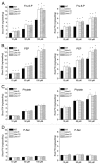Arabidopsis purple acid phosphatase 10 is a component of plant adaptive mechanism to phosphate limitation
- PMID: 22476468
- PMCID: PMC3443907
- DOI: 10.4161/psb.19019
Arabidopsis purple acid phosphatase 10 is a component of plant adaptive mechanism to phosphate limitation
Abstract
When grown with inadequate quantities of inorganic phosphate (Pi), plants synthesize and secret acid phosphatases into the rhizosphere. These secreted acid phosphatases are thought to release the Pi group from organophosphates present in the surrounding environment and to thereby increase Pi availability to plants. So far, however, the genetic evidence to support this hypothesis is still lacking. Previously, we showed that overexpression of Arabidopsis purple acid phosphatase 10 (AtPAP10) improved the growth of plants on Pi-deficient medium (P⁻ medium) supplemented with the organophosphate compound ADP; in contrast, the growth of atpap10 mutant lines was reduced on the same medium. In the current research, we determined the growth performance of these lines on P⁻ medium supplemented with four other organophosphates. The results showed that AtPAP10 could utilize rhizosphere organophosphates other than ADP for plant growth but with different utilization efficiencies. This work provides further genetic evidence that AtPAP10 phosphatase is a component of plant adaptive mechanism to Pi limitation.
Figures


Similar articles
-
A major root-associated acid phosphatase in Arabidopsis, AtPAP10, is regulated by both local and systemic signals under phosphate starvation.J Exp Bot. 2014 Dec;65(22):6577-88. doi: 10.1093/jxb/eru377. Epub 2014 Sep 22. J Exp Bot. 2014. PMID: 25246445 Free PMC article.
-
The Arabidopsis purple acid phosphatase AtPAP10 is predominantly associated with the root surface and plays an important role in plant tolerance to phosphate limitation.Plant Physiol. 2011 Nov;157(3):1283-99. doi: 10.1104/pp.111.183723. Epub 2011 Sep 22. Plant Physiol. 2011. PMID: 21941000 Free PMC article.
-
Comparative genetic analysis of Arabidopsis purple acid phosphatases AtPAP10, AtPAP12, and AtPAP26 provides new insights into their roles in plant adaptation to phosphate deprivation.J Integr Plant Biol. 2014 Mar;56(3):299-314. doi: 10.1111/jipb.12184. J Integr Plant Biol. 2014. PMID: 24528675
-
Functions and regulation of phosphate starvation-induced secreted acid phosphatases in higher plants.Plant Sci. 2018 Jun;271:108-116. doi: 10.1016/j.plantsci.2018.03.013. Epub 2018 Mar 14. Plant Sci. 2018. PMID: 29650148 Review.
-
The multifaceted nature of plant acid phosphatases: purification, biochemical features, and applications.J Enzyme Inhib Med Chem. 2023 Dec;38(1):2282379. doi: 10.1080/14756366.2023.2282379. Epub 2023 Nov 20. J Enzyme Inhib Med Chem. 2023. PMID: 37985663 Free PMC article. Review.
Cited by
-
Genome-Wide Analysis, Identification, and Transcriptional Profile of the Response to Abiotic Stress of the Purple Acid Phosphatases (PAP) Gene Family in Apple.Int J Mol Sci. 2025 Jan 24;26(3):1011. doi: 10.3390/ijms26031011. Int J Mol Sci. 2025. PMID: 39940779 Free PMC article.
-
Arabidopsis phosphatase under-producer mutants pup1 and pup3 contain mutations in the AtPAP10 and AtPAP26 genes.Plant Signal Behav. 2015;10(7):e1035851. doi: 10.1080/15592324.2015.1035851. Plant Signal Behav. 2015. PMID: 26251878 Free PMC article.
-
A major root-associated acid phosphatase in Arabidopsis, AtPAP10, is regulated by both local and systemic signals under phosphate starvation.J Exp Bot. 2014 Dec;65(22):6577-88. doi: 10.1093/jxb/eru377. Epub 2014 Sep 22. J Exp Bot. 2014. PMID: 25246445 Free PMC article.
-
Molecular signatures that translate across omics layers and crops under high aluminium and low phosphorus stress facilitate the identification of reliable molecular targets for genotyping in lentil.Funct Integr Genomics. 2025 Mar 5;25(1):52. doi: 10.1007/s10142-025-01542-z. Funct Integr Genomics. 2025. PMID: 40042647
References
-
- Richardson AE. Regulating the phosphorus nutrition of plants: molecular biology meeting agronomic needs. Plant Soil. 2009;322:17–24. doi: 10.1007/s11104-009-0071-5. - DOI
Publication types
MeSH terms
Substances
LinkOut - more resources
Full Text Sources
Molecular Biology Databases
Research Materials
Miscellaneous
